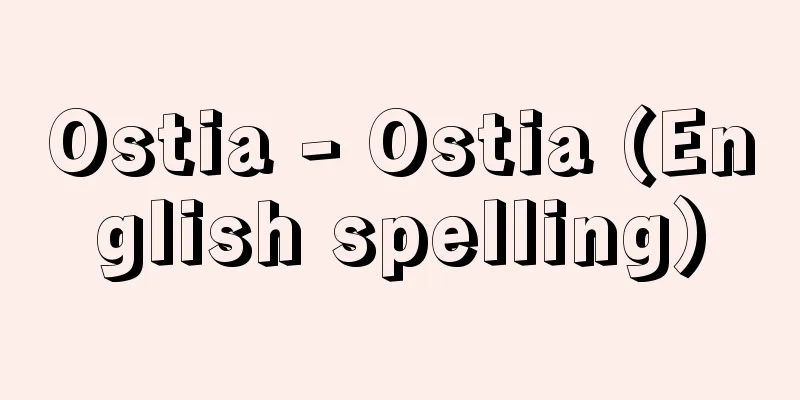Ostia - Ostia (English spelling)

|
An ancient Roman city at the mouth of the Tiber River (old name Tiber River) in Italy. It was built as a port, but due to the shifting of the coastline, the ruins are now located slightly inland. According to legend, it is the place where the hero Aeneas landed, or it was built by the ancient Roman king Ancus Marcius to obtain salt, but in fact it was built as a colony in the second half of the 4th century BC to defend the coastline. The etymology of the word ostium means "mouth of a river." During the Punic Wars it functioned as a Roman naval port, but after Rome conquered the Mediterranean it became a port for importing goods to Rome, with large quantities of grain and luxury goods being unloaded. It developed as a Roman-style city, with villas for Roman aristocrats, goods exchanges, shops, temples, entertainment facilities, and apartments for ordinary citizens lined the streets. It also became an entrance for Greek and Oriental religions and cultures, and many temples and churches were built for Isis, Serapis, the Earth Goddess, Mithras, and Christ, which were foreign to Rome. There are also floor mosaics and murals in the exchange and barracks that are worth seeing. The Roman politician Sulla in the 1st century BC established port facilities, but due to the wind and waves making it difficult to enter the port and the accumulation of landslides, during the Imperial period Emperors Claudius and Trajan built a new port about 2 kilometers northwest. As a result, Ostia, which had a population of over 100,000 at its peak, rapidly declined in the 3rd and 4th centuries and was eventually abandoned. It was excavated in earnest in 1909, and the nearby cemetery was also investigated. Today, the streets have been completely excavated and it has become a large archaeological park, providing valuable information on daily life in the Roman era, on a par with Pompeii. [Nobuo Matsumoto] Source: Shogakukan Encyclopedia Nipponica About Encyclopedia Nipponica Information | Legend |
|
イタリア、テベレ川(古称ティベリス川)河口にあった古代ローマ都市。港として建設されたが、現在は海岸線の移動により、やや内陸に入った所に遺跡がある。伝説によれば、英雄アイネイアス上陸の地とも、古ローマの王アンクス・マルキウスが塩を得る目的でつくったともいうが、実際は紀元前4世紀後半、海岸線防衛のために植民市として建設されたもの。語源は「河口」を意味するオスティウムostium。ポエニ戦争中はローマの軍港として機能したが、ローマの地中海制覇後はローマへの物資輸入港となり、穀物や奢侈(しゃし)品が多量に荷揚げされた。ローマ風都市として発展し、ローマ貴族の別荘や物資取引所、商店、神殿、娯楽施設、一般民のアパートが建ち並んだ。ギリシア、オリエントの宗教・文化の受け入れ口ともなり、ローマにとっては外国系のイシス、セラピス、大地母神、ミトラス、キリストなどの神殿・教会が数多くつくられた。取引所や兵士営舎などの床モザイク、壁画にもみるべきものがある。前1世紀ローマの政治家スラが港湾設備を整えたが、風波を受けて入港することがむずかしく、土砂の堆積(たいせき)もあって、帝政期になるとクラウディウス、トラヤヌスの両帝は2キロメートルほど北西に新しい港を建設した。そのため最大時人口10万を超えたオスティアも3、4世紀には急速に衰え、やがて放棄された。1909年から本格的に発掘され、近郊の墓地も調査され、現在は街路が完全に掘り出されて大規模な遺跡公園となっており、ローマ時代の日常生活を知るうえではポンペイと並んで貴重な資料を提供している。 [松本宣郎] 出典 小学館 日本大百科全書(ニッポニカ)日本大百科全書(ニッポニカ)について 情報 | 凡例 |
Recommend
South
[1] 〘Noun〙① The name of a direction. The direction...
intervention study
...This is sometimes called a prospective study. ...
Jim Crow
A law that established segregation laws for blacks...
Camphor [town] - Camphor
A former town in Asa County, located in the wester...
Amidaji Temple (Wakayama)
...The indented coastline, the rough waves of the...
Pogodin, MP (English spelling) PogodinMP
… In the 1960s, Pan-Slavism was born in Russia, p...
Under den Linden (English spelling)
... The man who put an end to this stagnation was...
Ratesystem
...the movement aimed to realize peace and overth...
Mering, J.
…It is also called diethylbarbituric acid, and is...
Crazy prices - Kyoranbukka
Refers to a state of soaring prices. Following the...
Okinawan pufferfish - Okinawan pufferfish
...The fins are unmarked, the anal fin is pale an...
Dandoborogiku - Dandoborogiku
A naturalized plant native to North America, an an...
Dry paper mold - Kanshikishikei
…Usually, a material called a stencil paper is pl...
Decorative window
〘 noun 〙 A window for displaying goods or products...
Akebia pentaphylla (English spelling) Akebia pentaphylla
… [Susumu Terabayashi]. … *Some of the terminolog...
![Kamiura [town] - Kamiura](/upload/images/67cb3eb183ae8.webp)








